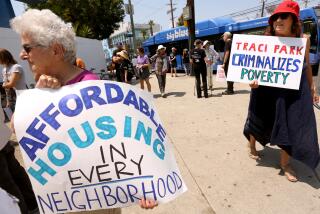Marchers Demand Aid for Homeless : Activists From Skid Row to Malibu Rally at Capitol
WASHINGTON — Tens of thousands of demonstrators, from residents of Skid Row shelters to owners of Malibu mansions, marched to the Capitol on Saturday to demand help in making the American dream of having a home come true for the nation’s swelling ranks of poor and homeless.
Organizers estimated that nearly 200,000 people, including many who had walked from as far away as New York and Pennsylvania, converged on the Mall in front of the Capitol to conclude a three-day protest seeking increased federal funding for construction of low-income housing.
Police initially estimated the crowd at 40,000, but as the day wore on under bright and blustery skies and more people continued to arrive, the long Mall became a nearly solid sea of humanity from the front of the Capitol to the foot of the Washington Monument nearly a mile away.
Message for Government
“We are here today because we believe that housing is a human right, not a privilege,” march organizer Barry Zigas, head of the National Low-Income Housing Coalition, told the cheering crowd. “We are here to tell our country, our government, our Congress and our President that we need housing and we need it now.”
The mile-long march along Constitution Avenue from the Washington Monument to the Mall climaxed a 72-hour “Housing Now!” campaign organized by Zigas’ group and more than 200 other organizations ranging from the AFL-CIO to the YWCA.
On the preceding two days, hundreds of activists canvassed Congress and knocked on government doors in an effort to dramatize the plight of the homeless and the growing number of low-income wage earners who are, in the words of one activist, “only a paycheck away from disaster.”
Kemp Promises Assistance
On Friday, Zigas and a group of homeless people met with Housing Secretary Jack Kemp, who later issued a “letter of understanding” promising to make the scandal-plagued Department of Housing and Urban Development a more effective institution in the war on poverty and homelessness.
Kemp promised to make an estimated 5,000 dwellings--10% of HUD’s inventory of foreclosed single-family houses--available to the homeless next year.
But Housing Now! activists, who estimate the number of homeless in America at 3 million, say more is needed. They want the government to start by restoring the roughly $25 billion cut from federally assisted housing programs during the Ronald Reagan years.
Attacking Reagan’s record on poverty, Ohio Democratic Gov. Richard F. Celeste, one of the speakers at Saturday’s rally, noted that the Bush Administration recently came up with $1 billion in disaster relief for “the poor souls made homeless by Hurricane Hugo.”
“Now,” Celeste added, “we need billions for the poor souls made homeless by Hurricane Ronnie.”
Assembling shortly before noon at the Washington Monument, the main procession linked up with another group of protesters arriving from the Pentagon for the final trek to the Capitol.
‘Build Homes, Not Bombs’
The Mall soon became a swaying, bobbing mass of balloons and placards with such inscriptions as “Build Homes, Not Bombs,” and “HUD loots billions. Millions go homeless.” One marcher wore a large cardboard box, painted to resemble a house, with a sign that said, “Boxes Shouldn’t Be Houses.” Several others carried a sheet-sized banner with foot-high letters reading, “The only thing that trickles down to the poor is rain.”
That sentiment was echoed by speaker after speaker who addressed an eclectic crowd that ranged from a group of homeless New Yorkers, who had set out for Washington on foot 16 days earlier, to more than 300 Hollywood celebrities, who flew in on chartered flights to lead the march and provide entertainment that made the day seem more like a celebration than a demonstration.
“There’s Superman,” exclaimed a teen-age girl, catching a glimpse of Christopher Reeve. “I was in love with him when I was young.”
“My God,” added her girlfriend, “He’s got gray hair. Superman has gray hair.”
Celebrities Lead March
Parade marshals linked arms and formed a walking cordon around the celebrities--including the Rev. Jesse Jackson, actresses Susan Dey and Valerie Harper, actor John Voight and singers Dionne Warwick and Rita Coolidge--as they led the march down Constitution Avenue.
“We’re here to help get attention for this cause,” Dey said of the celebrity contingent. “Congress meets next week to set its agenda, and we want the issue of affordable low-income housing to be on it.”
Not all of the stars and politicians attending the rally were so well received, however.
Washington Mayor Marion Barry, embroiled in scandals involving allegations of drug use and his personal life, was booed when he tried to address the crowd. “He’s embarrassed this city with his politics and greed,” one heckler said. Barry cut short his appearance and left the stage.
Largest in Years
Despite the conflicting crowd estimates, the demonstration was clearly the largest held in connection with homes and the homeless since the federal government, under Reagan, began cutting back on housing assistance by halting construction of low-income projects.
The argument then--and even now in some conservative circles--was that homelessness in America is a problem that has more to do with drug addiction and mental illness than with an actual housing shortage, which some HUD analysts say does not really exist.
This assertion was sharply disputed, however, by the speakers at Saturday’s rally and by many of the homeless in the crowd.
Blames High Rents
“Sure, there are drug addicts among the homeless, a lot of them maybe. But most of the homeless are productive, capable human beings who just can’t make ends meet with rents the way they are,” said Jorge Riviera, 23, of New York. “What with rents like they are, you got to have a college degree to afford New York. You can’t do it if you earn $4.50 an hour like me.”
Queen Fisher, who lives in South-Central Los Angeles, said she came to Washington for her four grandchildren, who share one room and get into fights when they go out on the streets to play.
“I want them to have a safe place to play,” she said. “I want them to have a life and a real home to live in. That’s why I came, for them and all the other poor people in South-Central Los Angeles.”
Varied Participants
Other participants included a Pennsylvania clerk who recently lost both his job and his apartment and who said: “If it can happen to me it can happen to most middle-class people”; an executive from New Jersey who said he felt guilty about “being able to afford a $500,000 house,” and a schoolteacher from New York who said she was “tired of stepping over bodies” when she left her Upper East Side home in the morning.
More to Read
Sign up for Essential California
The most important California stories and recommendations in your inbox every morning.
You may occasionally receive promotional content from the Los Angeles Times.










